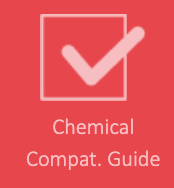Most chemical compatibility guides for rubber require total chemical exposure for 70 hours. The long-term exposure will provide a good representation of how the rubber will perform in an application when exposed to a specific chemical. Problems arise when the application is a short-term exposure, like splash exposure. Many rubbers can handle these types of applications even though the guides say the material is incompatible.
Rubber is a versatile material that is used in a wide variety of applications. It is essential to understand the chemical compatibility of rubber to ensure that it is compatible with the chemicals it will be exposed to in its intended use.
Several factors can affect rubber’s chemical compatibility, including the type of rubber, the additives used, and the processing conditions. The kind of rubber being used is the most critical factor, as different types of rubber have other chemical resistance properties. For example, Nitrile is suitable for exposure to fuels and oils, while EPDM rubber will swell under the same conditions.
The additives used in rubber can also affect its chemical compatibility. For example, antioxidants can help to protect rubber from oxidation, while plasticizers can make rubber more flexible. Depending on chemical exposure, plasticizers can be extracted from the rubber, resulting in less swell. However, once in a dry-out condition, the rubber will shrink. This shrinkage of the rubber can cause out-of-tolerance and leak paths. The processing conditions can also affect the chemical compatibility of rubber. For example, peroxide-cured rubber can have better chemical resistance than sulfur-cured systems.
It is crucial to test the chemical compatibility of rubber before using it in a particular application. This can be done by conducting a compatibility test or using a compatibility chart. A compatibility test involves exposing a sample of rubber to the chemical in question and then observing the results of that exposure. A compatibility chart lists the types of rubber compatible with different chemicals.
By understanding the chemical compatibility of rubber, it is possible to select the correct type of rubber for a particular application and avoid problems such as premature degradation or failure.
Testing Short Term Exposure
We tested four compounds to known high-swell fluids for the corresponding polymer.
- 27BN7AP – 70 NBR – Fluid Toluene
- 01VT7EE – 75 FKM ( 67% Fluorine) – MEK
- 06SL7AP – 70 Silicone – MEK
- 18EP7AP – 70 EPDM peroxide cured – #1 Oil
| 1 hr | 24 hr | 70 hr | ||
| Compound | Fluid | Volume Swell (%) | ||
| 27BN7AP | Toluene | 68 | 131 | 127 |
| 01VT7EE | MEK | 121 | 199 | NA |
| 06SL7AP | MEK | 38 | 52 | 50 |
| 18EP7AP | #1 Oil | 1 | 5 | 9 |
Conclusions
In our next set of tests, we need to look at a lower exposure time to show the performance of an actual splash-type test. From the data, you can see that EPDM is not recommended for oil, but at short-term exposure, you don’t get high-volume swell. If EPDM is exposed longer, it will keep absorbing the oil and result in a higher swell. The Silicone and NBR performed as we thought they would. Again, for short-term exposure, those compounds could work. FKM was unexpected for the short term. You can see it had a very high volume swell even at an hour. Since the swell was so high at 24 hours, we did not continue on to 70. Additional testing could be done on higher fluorine FKM compounds to see if they would work in the short term.
It is always important to look at chemical compatibility guides, but it is also important to know actual applications. Primarily when you are operating in very low percentage mixtures, this saves you the cost of using more expensive polymers that might not be needed.
